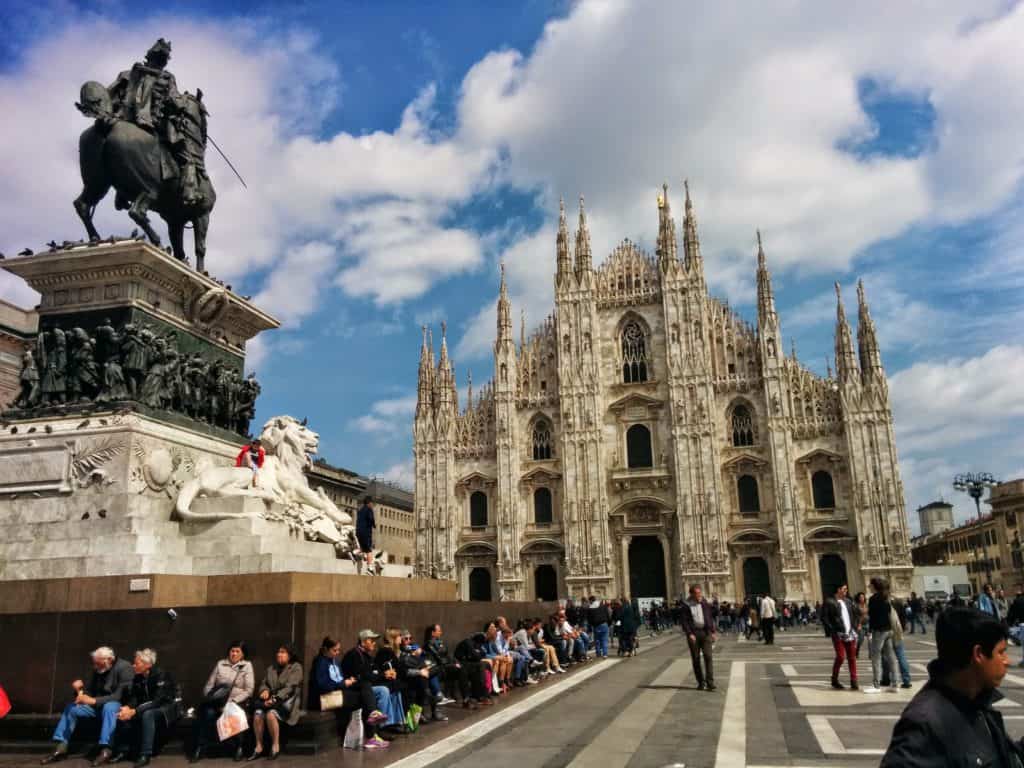Prehistoric
There were many groups of people living in Milan before it was founded by Gallic Insubre tribes in the 4th century BCE. Included in these are the Ligurians (3rd-2nd centuries BCE). Indo-European populations, and the Etruscans (5th century BCE). The Celts were defeated by armies lead by statesmen of the Roman Empire, around 222 BCE by Gnaeus Cornelius Scipio Calvus and by Claudius Marcellus in 222 BCE, after which the city became a commercial centre and from 286 to 402 ACE, the city was the capital of the Western Roman Empire.
During this period we see the rise of Sant’Ambrogio, a celebrated bishop. He built four of Milan’s basilicas: Sant’Ambrogio, San Lorenzo, San Nazaro, and San Simpliciano. He was the leading opponent of anti-Arianism movements at the time.
Early Middle Ages
In 402 BCE Milan lost its title as the imperial capital as it was attacked, sacked, and conquered by Atilla’s Hun army (452); the Germanic Eruli (476), and the Ostrogoths (489). The Goths completely destroyed the city when they were at war with the Byzantine Greeks.
Reconstruction of the city was underway by 568 BCE under Byzantine rule who ceded it the following year to the Lombards. The city of Milan was then ruled by our neighbours in Pavia. The Lombards were defeated by the Franks in 774 ACE, and after a series of fights and overruling, the city was lead by the archbishops in around 1000 ACE. in 1042 a city wall was built, and later destroyed in 1162 when it was razed to the ground by Frederick Barbarossa, who burnt the city. In 1176, Barbarossa was defeated by troops of the Lombard League which was composed of troops in Milan and other northern territories.
By the middle of the 13th century, Milan had established its canal network named the Navigli. The canals were meant to establish a link between the city and Ticino, Switzerland. The network came only to partial fruition, however.
The Visconti and Sforza Families
The Visconti family overthrew the Torriani family, invited artists to Milan to decorate the city, and commissioned new buildings like the Duomo di Milano and the Castello Sforzesco (Castello di Porta Giova at the time). The family pioneered expansion of the city. Gian Galeazzo (who was duke at the time) dreamed of a unified Italy. The Visconti dynasty ruled until 1447, after which there were three years of Ambrosian Republic. Francesco Sforza then brought an end to the expansion policy to ensure peace for the city. This led to a population boom and the city boasted 100,000 citizens. The Visconti castle was rebuilt and renamed: Castello Sforzesco.

This period also saw a great period for the culture of Milan. Lodovico “il Moro” Sforza was a politician known for his love of the arts, although under his policies, Milan’s freedom ended in 1499. Also during this period, great artists took up residence in Milan, such as Donato Bramante who designed the Santa Maria delle Grazie, and Leonardo da Vinci, who stayed in the city for around 20 years.
France and Spain - "Franza o Spagna purché se magna"
In the 16th century, Milan was a key city of strategic value for other countries in Europe. After Francesco Sforza died, Emperor Charles V became the city’s governor. The city continued to grow and expand, new city walls were built, named after the Spanish (of which all is left is in Porta Romana).
When Spanish rule ended (1706) the city was occupied by Austrian troops. Until 1859 Milan was a part of the Austro-Hungarian Empire (except from the Cinque Giornate rebellion and the Napoleonic period). From 1740 to 1780, the city was led by Maria Theresa. Milan also hosted the coronation of Napoleon in 1804. After Napoleon’s defeat, Milan was given back to the Habsburgs. Under this time, there were revolts, and the city was important in the struggle for Italian independence. This independence movement grew and culminated in the Cinque Giornate revolts.
After Italy's Unification
After Austrian rule in 1861, the City boasted around 240,000 occupants. By 1920 the city was an successful industrial and business city, and the population had grown to around 850,000. With the increased population came trade union foundations, and the growth of socialist groups. There were tensions amongst classes which erupted in a violent protest in 1898. The artistic movement of Futurism led pro-intervention movements during World War I, and then the rise of Facism. The Facist movement was founded in Milan in 1919 by Benito Mussolini who had a close connection to the city. It was in this period that pompous works and examples of innovative architecture were built; the Central Station and the Triennale are two of them. Milan was destroyed by war over the ensuing years, and became a centre of allied resistance. Mussolini was shot in Giulino di Mezzegra, and his body, along with other members of the facist party, were dumped and hung in Milan’s Loreto Square, for all the public to see.
At the end of World War II Lombardy was instrumental in the boom that transformed Italy into an industrial world leader. Milan became a major financial centre which induced immigration, especially in the south. In the last decade, Milan has led economic expansion in Italy, hosting the 2015 World Exposition. A number of award-winning works of architecture symbolize Milan’s status as Italy’s shining light city for finance, art, industry, and scientific research.
Roshan Ratnayaka, writing for acadimat.com, 2020
